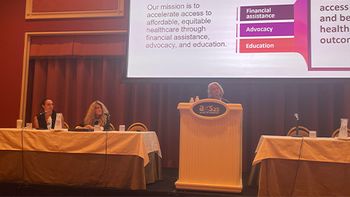
Linguistic Validation: Amplifying the Patient Voice
Designing and managing clinical outcome assessments on an international basis is more than a translation task. It requires the more discrete practice of linguistic validation, writes Dana Weiss.
The steady rise of the patient voice over recent years is both highly welcome and long overdue in the eyes of patient populations and their healthcare and regulatory advocates. Amplifying this voice so that patient concerns and fears are heard, acknowledged and taken on board at critical points in drug planning and development is increasingly important strategically for drugs companies too.
But capturing consistent, comparable real-world feedback is easier said than done across global populations. Here, Dana Weiss explains how linguistic validation can help bridge cultural as well as language differences so that the combined voice of global populations can be trusted as valid and meaningful real-world evidence in support of clinical trial progression.
To honour their pledge to be more responsive to patients, and progress their strategic missions to differentiate portfolios in new and more effective ways, life sciences companies have acknowledged and embraced the importance of listening to target populations much earlier in the product planning, research and development lifecycle. This can be seen reflected in a growing emphasis on observational research, focus groups, social listening and broader real-world data, as strategies for trying to understand what patients need and want at a much more embryonic stage.
As well as portraying the company as more patient-centric, the move offers sponsors a chance to develop more of what the market is demanding, and to hone their clinical trial activities. The more they understand about a condition and patients’ experiences up front, the better chance they have of developing something that will be positively adopted by the market, and which will significantly improve outcomes.
These developments in turn have led to a rise in new translation workloads in support of multi-national clinical trials. To ensure the value of international patient focus groups and other early-stage initiatives to capture the patient viewpoint, life sciences organizations need a way to capture and process this feedback consistently across different nationalities and cultures. The objective is to have clinical outcome assessments (COAs) completed in one part of the world equivalent and comparable to those completed in another.
As straightforward as this might sound however, achieving that global consistency is proving an all-too-common stumbling block for clinical trial sponsors and contract research organizations (CROs), and the issue is more than one of language.
Meaningful references
Designing and managing clinical outcome assessments on an international basis is more than a translation task: it requires the more discrete practice of linguistic validation. This goes beyond ensuring accurate translations of forms (appropriate vocabulary, spelling, grammar and word order), to ensure that points of reference are culturally relevant for those making the assessments.
Researchers have recognized the increasing importance of asking patients targeted questions assessing the effects of the condition on their ability to function in their daily lives. For example, instead of asking patients to rate their pain on a numerical scale, far more relevant data are obtained when patients are asked what their pain prevents them from doing. As daily activities vary from culture to culture, the cultural adaptation of these questions becomes critically important for the valid analysis of pooled data across languages and cultures
If the COA’s area of interest is to assess patients’ shoulder mobility, for example, and an original option for describing this is ‘I am able to shovel snow’, the translation challenge is not simply to convert this to the local language, but to consider too whether this statement has global application. Since large parts of the world do not experience snow, a literal translation will not suffice – otherwise it will yield high instances of ‘don’t know’ or ‘not applicable’ responses in those markets. These in turn would skew the international picture, threatening the value of the total patient evidence.
Effective linguistic validation involves controlled cross-cultural adaptation. Where given criteria are met (‘hot climate in target locale/ no snow’), the team would adapt the source statement to an accepted equivalent to maintain a consistent response. So in regions with persistently warm climates, ‘I am able to shovel snow’ is changed to ‘I am able to lift heavy grocery bags and place them on a counter’ in the target language. Other cultural considerations might include the local diet, if the subject of the COA is digestive disorders. Here, the original Western statement, ‘I am able to eat soft foods such as mashed potatoes and oatmeal’ might be adapted to ‘I am able to eat soft foods such as rice and khichdi’ further east.
Subtler still, but just as critical, would be the ability to differentiate between different responses to or definitions of quality of life. So that, when assessing the impact on self-perception of patients undergoing treatment for breast cancer, for example, teams are aware that ‘I am embarrassed by my appearance’ could be equal to the statement ‘I am self-conscious about my appearance’ in another culture.
It is these subtleties that a great many companies struggle with. Typically this is because their designated teams do not have the awareness, training or authorization to recognise the issues, and/or make appropriate judgement calls (in partnership with the trial sponsor) to protect the integrity and value of international COA data. But this introduces risk. If the collective patient data is called into question, it could jeopardize acceptance of labeling claims. COAs are vital to the progression of all clinical trials.
Observing best practice
Although there isn’t a legal requirement for standard approaches to translation and linguistic validation, the major health authorities – certainly EMA, FDA and PMDA in Japan – support best practice in the interests of quality and patient safety.
The life sciences industry does appreciate this need, particularly as linguistic validation is inexpensive and the word counts tend to be quite modest. After all, getting any of this wrong can be costly: if an entire clinical study is invalidated at a late phase, the cost could run into hundreds of millions of dollars. The barriers tend to be practical: (a) failure to consider the requirement early enough in the cycle to allow the time to manage it, and/or (b) a lack of internal capability.
Fortunately, all of this can be readily addressed through appropriate partnership and access to specialist skills. Certainly the ability to consistently identify the need for cultural adaptation and determine the appropriate course of action should not be left to inexperienced teams. It isn’t only that designated language services providers would be tuned into these issues; they would also know the right channels to go through to confer with the client - and be able to make informed recommendations to maintain COA content equivalence, thus protecting the form’s intent and the integrity of the overall feedback.
With the needs and preferences of the patient now high on the strategic agenda for life sciences, it is important that companies establish a reliable, repeatable means to manage international real-world data channels - particularly where the accuracy of feedback is pivotal to clinical trial acceptance.
It is well worth companies making the requisite provisions now for a workload that will only grow. That’s because there is little doubt that this more open and comprehensive approach to market research is the way the industry is fast becoming the norm - just as it should be.
About the author
Newsletter
Lead with insight with the Pharmaceutical Executive newsletter, featuring strategic analysis, leadership trends, and market intelligence for biopharma decision-makers.





